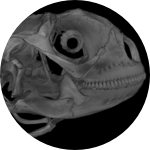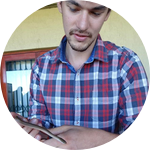About This Project
Chameleonids are a famous family of lizards mostly known for their incredible color change ability. However, contrary to the common belief, chameleons don't change color for camouflage but to communicate. But what could they say to each other? That's what we try to answer in our project by investigating the color change during courtship, to see if the male is giving relevant information about his quality as reproducer or as father (ex: good genes), or if he's just a smooth talker.
Ask the Scientists
Join The DiscussionWhat is the context of this research?
During sexual selection, animals rely on communication signals to choose their mates. This choice can rely on signals produced during a short period of time, called events. In some cases, events, like mate calls in some tree frogs, can be a driver a speciation by creating a pre-copulatory barrier. However, even if mate calls are intuitive to us, some animals , including as octopuses, cuttlefishes, and chameleons, rely mostly on their eyesight to communicate and use their incredible color change ability to communicate. Here I propose to investigate if color changing ability, like mate calls, can drive speciation using chameleon as biological model.
What is the significance of this project?
This project will shed light on the meaning of the color change during sexual selection in chameleon and help us better understand the selective pressure that drove their diversification.
Results concerning what signals the mate choice relies on can be used for the management of invasive species of chameleons (e.g. Trioceros Jacksonii and Chamaeleo calyptratus); or used by chameleon's breeders to improve their clutches and mating.
What are the goals of the project?
In this project, we aimed to study the color change ability of chameleons during courtship. However, a lot of studies on animal colors have been based on our visual perception, on our eyesight, while most of the animals have a different visual system and thus different visual perception. That's why, here, we propose to study the color change but through the chameleon's eyes by using a set of cameras that can record in their visual spectrum, from UV to near infrared.
We want to study especially the color change in chameleon because they mostly use this ability to communicate, thus we want to know what could they say to each other especially during courtship. Is the male just a smooth talker, saying what the female wants? Or is he showing honestly his overall quality as a male?
Budget
This budget will be used to buy 3 UV converted HD camera (Nikon D7200) to record the courtship but in the UV light, that human eyes and non-converted cameras cannot detect.
We choose this precise type of camera because they are already compatible with the color analysis software we want to use (Troscianko & Witte, 2015).
Endorsed by
Meet the Team
Team Bio
The COCOON project is compose of an interdisciplinary team involving several field of biology: Ecology, Evolution, Physiology, Functional Morphology, Modelling, Herpetology, Ophtalmology and Animal Behavior.
For more details about each members please visit this links:
http://alexisdollion.wixsite.c...
http://alexisdollion.wixsite.c...
Alexis Y. DOLLION
I'm a young PhD student in Evolutionary Biology/Behavioral Ecology/Sensory Ecology/Herpetology at the Institute of Ecology and Environmental Sciences of Paris (IEES Paris) under the guidance of Pr. Sandrine MEYLAN and Dr. Anthony HERREL.
I'm from a small village in Normandy (Noth-West of France); and as far as I can remember, I've always been surrounded by animals and always been intrigued by their diversity and they behavior; and I always wonder what if I could understand them? Is it possible? That why I followed the path of ecology and evolutionary biology, to understand what has lead them to such diversity and how do they interact between them and their environment.
During my first two internship under the guidance of the Dr. Herrel and Dr. Cornette, I've worked on an unsual and yet passioning biological model... the chameleons; and develop a passion for this family of lizards, but also for reptiles and amphibians in general. I'm particularly interested by this group of vertabrates because they are misunderstood, victims of numerous myth and believes and poorly studied in animal behavior and sexual selection.
All my research experiences were about reptiles, and more precisely lizards. During those intersnships, I've studied lizards from a variety of fields, from functional morphology to demographic modelling, passing by genetics, physiology and animal behavior.
And now I'm performing my own PhD project untitled "COlor Changing, Origin Of New species? The chameleon case" Or the COCOON project. This project is aimed to understand the information convey by the color change during courtship and how this ability might have drive chameleon's diversification.
Lab Notes
Nothing posted yet.
Project Backers
- 2Backers
- 1%Funded
- $54Total Donations
- $27.00Average Donation

